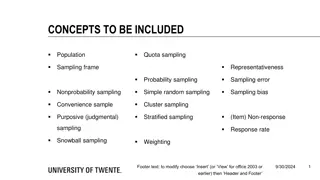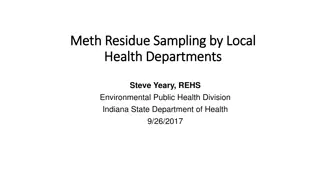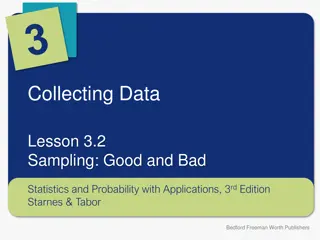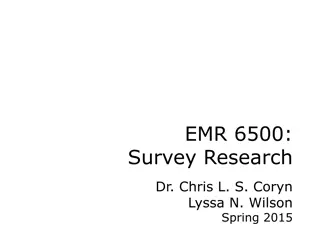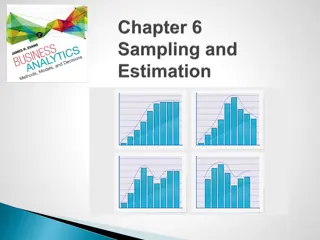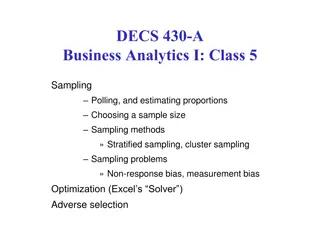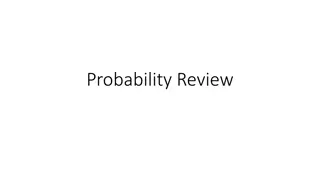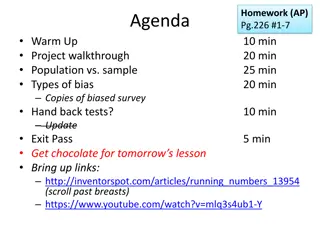Understanding Non-Probability Sampling Techniques in Nursing Research
Non-probability sampling in nursing research involves selecting samples subjectively rather than randomly. This sampling method carries a higher risk of bias and limits statistical inference about the entire population. Five main types include convenience, purposive, quota, snowball, and voluntary response sampling, each with its own characteristics and applications. Convenience sampling selects individuals based on availability, while purposive sampling relies on the researcher's judgment. These techniques offer advantages in certain research contexts but must be used judiciously due to their limitations.
Download Presentation

Please find below an Image/Link to download the presentation.
The content on the website is provided AS IS for your information and personal use only. It may not be sold, licensed, or shared on other websites without obtaining consent from the author. Download presentation by click this link. If you encounter any issues during the download, it is possible that the publisher has removed the file from their server.
E N D
Presentation Transcript
Sample and sampling unit 5 part2 L6
Nonprobability Sampling Definition: Non-probability sampling is defined as a sampling technique in which the researcher selects samples based on the subjective judgment of the researcher rather than random selection. Most nursing research involve this type of sampling procedure
In a non-probability sample, individuals are selected based on non-random criteria, and not every individual has a chance of being included. This type of sample is easier and cheaper to access, but it has a higher risk of sampling bias and can t be used it to make valid statistical inferences about the whole population.
There are five main types of non-probability sample: 1. Convenience sampling 2. Purposive sampling 3. Quota sampling 4. Snowball sampling 5. Voluntary response sampling
1. Convenience sampling In convenience sampling, we select individuals into our sample based on their availability to the investigators rather than selecting subjects at random from the entire population. As a result, the extent to which the sample is representative of the target population is not known.
Examples Stopping people at a street corner to conduct an interview is sampling by convenience. Other example, we might approach patients seeking medical care at a particular hospital in a waiting or reception area. Convenience samples are useful for collecting preliminary or pilot data ) be used with caution for statistical inference, since they may not be representative of the target population. These approaches are subject to bias , but they should (
2. Purposive Sampling Purposive sampling (also known as selective or subjective sampling) is a sampling technique in which researcher relies on his or her own judgment when population to participate in the study.. It is often used in qualitative research , where the researcher wants to gain detailed knowledge about a specific phenomenon rather than make statistical inferences. judgment, choosing members of
This sampling method requires researchers to have prior knowledge about the purpose of their studies so that they can properly choose and approach eligible participants. Researchers use purposive sampling when they want to access a particular subset of people, as all participants of a study are selected because they fit a particular profile.
Example: You want to know more about the opinions and experiences of disabled university, so you purposefully select a number of students with different support needs in order to gather a varied range of data on their experiences with student services. students at your
3. Quota Sampling Quota homogeneous representation of the subgroups in the sample; within each stratum subjects are sampled by convenience. Quota sampling is similar to sampling in the first step. The difference that stratified random sampling involve random sampling method of obtaining sample members, whereas quota sampling obtains members through convenience sample because the sampling frame is unknown. sampling divides (subpopulations) the population into strata to ensure stratified random
Therefore, the sample may not be representative of the population. The bases for stratification should be a variable of importance to the study. These variables frequently include subject attributes such as age. gender, background. The number of element chosen from each stratum is generally in proportion to the size of that stratum in the total population . and educational
As an example, suppose we were interested in studying the attitudes of undergraduate nursing students toward working immunodeficiency syndrome (AIDS) unit. The accessible population is a nursing school with an enrollment of 500 undergraduates; a sample size of 100 students convenience sample, questionnaires to 100 students as they entered the nursing school library on an acquired is desired. could With distribute a we
In this example, the convenience sample seriously over represents women and under represents men. In a quota sample, researchers can guide the selection of subjects so that the sample includes an appropriate number of cases from both strata
NUMBERS AND PERCENTAGES OF STUDENTS IN STRATA OF A POPULATION, CONVENIENCE SAMPLE, AND QUOTA SAMPLE STRATA POPULATION CONVENIENCE SAMPLE 5(5%) QUOTA SAMPLE 20(20%) Male 100(20%) Female 400(80%) 95(95%) 80(80%) Total 500(100%) 100(100%) 100(100%)
4. Snowball sampling If the population is hard to access, snowball sampling can be used to recruit participants via other participants. The number of people you have access to snowballs as you get in contact with more people. After gaining the trust of a few people, the researchers could ask recommend some other members of the group. By proceeding from one recommendation to the next, the researchers may be able to gain a large enough sample for their project. the participants to
Example You are researching experiences of homelessness in your city. Since there is no list of all homeless people in the city, probability sampling isn t possible. You meet one person who agrees to participate in the research, and she or he puts you in contact with other homeless people that she or he knows in the area.
This method of sampling is often used when the research population is people with specific traits who might otherwise be difficult to identify (e.g., people who are afraid of hospitals).
5. Voluntary response sampling Similar to a convenience sample, a voluntary response sample is mainly based on ease of access. Instead of the researcher choosing participants and directly contacting them, people volunteer themselves (e.g. by responding to a public online survey). Voluntary response samples are always at least somewhat biased, as some people will inherently be more likely to volunteer than others.
Who Uses Voluntary Sampling? Within volunteer samples by either asking students to participate in research or by looking for people in the community. academia, researchers often seek Within industry, companies seek volunteer samples for a variety of research purposes.
Example You send out the survey to all students at your college and a lot of students decide to complete it. This can certainly give you some insight into the topic, but the students who responded are more likely to be those who have strong opinions about the topic, so you can t be sure that their opinions are representative of all students.
Sample size This is the sub-population to be studied in order to make an inference to a reference population population to which the findings from a study are to be generalized) In census, the sample size is equal to the population size. However, in research, because of time constraint and budget, a representative sample are normally used. (A broader
Most statisticians agree that the minimum sample size to get any kind of meaningful result is 100. If your population is less than 100 then you really need to survey all of them. A good maximum sample size is usually around 10% of the population, as long as this does not exceed 1000. For example, in a population of 5000, 10% would be 500. In a population of 200,000, 10% would be 20,000. This exceeds 1000, so in this case the maximum would be 1000.
Even in a population of 200,000, sampling 1000 people will normally give a fairly accurate result. Sampling more than 1000 people won t add much to the accuracy given the extra time and money it would cost.
Choose a number between the minimum and maximum depending on the situation Suppose that you want to survey students at a school which has 6000 pupils enrolled. The minimum sample would be 100. This would give you a rough, but still useful, idea about their opinions. The maximum sample would be 600, which would give you a fairly accurate idea about their opinions.
Choose a number closer to the minimum if: 1. You have limited time and money. 2. You only need a rough estimate of the results. 3. You don t plan to divide the sample into different groups during the analysis, or you only plan to use a few large subgroups (e.g. males / females). 4. You think most people will give similar answers. 5. The decisions that will be made based on the results do not have significant consequences.
Choose a number closer to the maximum if: 1. You have the time and money to do it. 2. It is very important to get accurate results. 3. You plan to divide the sample into many different groups during the analysis (e.g. different age groups, socio-economic levels, etc). 4. You think people are likely to give very different answers. 5. The decisions that will be made based on the results of the survey are important, expensive or have serious consequences.
In practice most people normally want the results to be as accurate as possible, so the limiting factor is usually time and money. In the example above, if you had the time and money to survey all 600 students then that will give you a fairly accurate result. If you don t have enough time or money then just choose the largest number that you can manage, as long as it s more than 100.
There are few instances in descriptive behavioral research when a sample size smaller than 30 or larger than 500 can be justified. As a role, a sample size of 30 should be considered as the minimum size for each group that is studied. It is always wise to set the sample size a little bit larger than what is actually desired (to allow for non response or subject dropout)
Sampling bias Sampling bias refers to the systematic overrepresentation or underrepresentation of some segment of the population. Sampling bias occurs when samples are not carefully selected by the researcher. .
30 elmor@hotmail.com







